Coherent Backscattering by Large Ice Crystals of Irregular Shapes in Cirrus Clouds
Abstract
:1. Introduction
2. Scattering Matrix for the Models of Ice Crystal Aggregates
3. The Scattering Matrixes Calculated in the Physical-Optics Approximation
4. The Scattering Matrix for Other Size and Shapes of the Particles
5. Grazing-Incidence Trajectories and the Backscattering Peak
6. Interference of the Grazing-Incidence Beams
7. Conclusions
Author Contributions
Funding
Institutional Review Board Statement
Informed Consent Statement
Data Availability Statement
Acknowledgments
Conflicts of Interest
References
- Liou, K.-N.; Yang, P. Light Scattering by Ice Crystals. Fundamentals and Applications; Cambridge University Press: Cambridge, UK, 2016; p. 460. [Google Scholar]
- Tsekeri, A.; Amiridis, V.; Louridas, A.; Georgoussis, G.; Frendenthaler, V.; Metallinos, S.; Doxastakis, G.; Gasteiger, J.; Siomos, N.; Paschou, P.; et al. Polarization lidar for detecting dust orientation: System design and calibration. Atmos. Meas. Tech. 2021, 14, 7453–7474. [Google Scholar] [CrossRef]
- Mishchenko, M.I.; Rosenbush, V.K.; Kiselev, N.N.; Lupishko, D.F.; Tishkovets, V.P.; Kaydash, V.G.; Belskaya, I.N.; Efimov, Y.S.; Shakhovskoy, N.M. Polarimetric Remote Sensing of Solar System Objects; Akademperiodika: Kyiv, Ukrain, 2010; p. 291. [Google Scholar]
- Mishchenko, M.I.; Hovenier, J.W.; Travis, L.D. Light Scattering by Nonspherical Particles; Academic: San Diego, CA, USA, 2000; p. 720. [Google Scholar]
- Yang, P.; Liou, K.N. Light scattering by hexagonal ice crystals: Comparison of finite-difference time domain and geometric optics models. J. Opt. Soc. Am. 1995, A12, 162–176. [Google Scholar] [CrossRef]
- Yang, P.; Liou, K.N. Geometric-optics-integral-equation method for light scattering by nonspherical ice crystals. Appl. Opt. 1996, 35, 6568–6584. [Google Scholar] [CrossRef] [PubMed]
- Masuda, K.; Ishimoto, H.; Mano, Y. Efficient method of computing a geometric optics integral for light scattering by nonspherical particles. Pap. Meteorol. Geophys. 2012, 63, 15–19. [Google Scholar] [CrossRef]
- Muinonen, K. Scattering of light by crystals: A modified Kirchhoff approximation. Appl. Opt. 1989, 28, 3044–3050. [Google Scholar] [CrossRef]
- Iwasaki, S.; Okamoto, H. Analysis of the enhancement of backscattering by nonspherical particles with flat surfaces. Appl. Opt. 2001, 40, 6121–6129. [Google Scholar] [CrossRef] [PubMed]
- Sato, K.; Okamoto, H. Characterization of Z(e) and LDR of nonspherical and inhomogeneous ice particles for 95-GHz cloud radar: Its implication to microphysical retrievals. J. Geophys. Res. 2006, 111, D22213. [Google Scholar] [CrossRef]
- Bi, L.; Yang, P.; Kattawar, G.W.; Hu, Y.; Baum, B.A. Scattering and absorption of light by ice particles: Solution by a new physical-geometric optics hybrid method. J. Quant. Spectrosc. Radiat. Transf. 2011, 112, 1492–1508. [Google Scholar] [CrossRef]
- Baran, A.J.; Ishimoto, H.; Sourdeval, O.; Hesse, E.; Harlow, C. The applicability of physical optics in the millimetre and sub-millimetre spectral region. Part II: Application to a three-component model of ice cloud and its evaluation against the bulk single-scattering properties of various other aggregate models. J. Quant. Spectrosc. Radiat. Transf. 2018, 206, 83–100. [Google Scholar] [CrossRef]
- Hesse, E.; Taylor, L.; Collier, C.T.; Penttila, A.; Nousiainen, T.; Ulanowski, Z. Discussion of a physical optics method and its application to absorbing smooth and slightly rough hexagonal prisms. J. Quant. Spectrosc. Radiat. Transf. 2018, 218, 54–67. [Google Scholar] [CrossRef]
- Konoshonkin, A.V.; Borovoi, A.G.; Kustova, N.V.; Shishko, V.A.; Timofeev, D.N. Light Scattering by Atmospheric Ice Crystals within the Physical Optics Approximation; FIZMATLIT: Moscow, Russia, 2022; p. 384. (In Russian) [Google Scholar]
- Kokhanenko, G.P.; Balin, Y.S.; Klemasheva, M.G.; Nasonov, S.V.; Novoselov, M.M.; Penner, I.E.; Samoilova, S.V. Scanning Polarization Lidar LOSA-M3: Opportunity for Research of Crystalline Particle Orientation in the Clouds of Upper Layers. Atmos. Meas. Tech. 2020, 13, 1113–1127. [Google Scholar] [CrossRef]
- Reichardt, J.; Wandinger, U.; Klein, V.; Mattis, I.; Hilber, B.; Begbie, R. RAMSES: German Meteorological Service autonomous Raman lidar for water vapor, temperature, aerosol, and cloud measurements. Appl. Opt. 2012, 51, 8111–8131. [Google Scholar] [CrossRef] [PubMed]
- Zubko, E.; Shmirko, K.; Pavlov, A.; Sun, W.; Schuster, G.L.; Hu, Y.; Stamnes, S.; Omar, A.; Baize, R.R.; McCormick, M.P.; et al. Active remote sensing of atmospheric dust using relationships between their depolarization ratios and reflectivity. Opt. Lett. 2021, 46, 2352–2355. [Google Scholar] [CrossRef]
- Zubko, E.; Weinbergern, A.J.; Zubko, N.; Shkuratov, Y.; Videen, G. Umov effect in single-scattering dust particles: Effect of irregular shape. Opt. Lett. 2017, 42, 1962–1965. [Google Scholar] [CrossRef] [PubMed]
- Grynko, Y.; Shkuratov, Y.; Forstner, J. Intensity surge and negative polarization of light from compact irregular particles. Opt. Lett. 2018, 43, 3562–3565. [Google Scholar] [CrossRef]
- Grynko, Y.; Shkuratov, Y.; Forstner, J. Light scattering by irregular particles much larger than the wavelength with wavelength-scale surface roughness. Opt. Lett. 2016, 41, 3491–3494. [Google Scholar] [CrossRef] [PubMed]
- Mishchenko, M.I.; Travis, L.D.; Lacis, A.A. Multiple Scattering of Light by Particles: Radiative Transfer and Coherent Backscattering; Cambridge University Press: Cambridge, UK, 2006; p. 478. [Google Scholar]
- Mishchenko, M.I.; Dlugach, J.M.; Liu, L.; Rosenbush, V.K.; Kiselev, N.N.; Shkuratov, Y.G. Direct solutions of the Maxwell equations explain opposition phenomena observed for high-albedo solar system objects. Astrophys. J. Lett. 2009, 705, L118–L122. [Google Scholar] [CrossRef]
- Muinonen, K. Coherent backscattering of light by complex random media of spherical scatterers: Numerical solution. Waves Random Media 2004, 14, 365–388. [Google Scholar] [CrossRef]
- Ozrin, V.D. Exact solution for coherent backscattering of polarized light from a random medium of Rayleigh scatterers. Waves Random Media 1992, 2, 141–164. [Google Scholar] [CrossRef]
- Penttilä, A.; Lumme, K.; Hadamcik, E.; Levasseur-Regourd, A.-C. Statistical analysis of asteroidal and cometary polarization phase curves. Astron. Astrophys. 2005, 432, 1081–1090. [Google Scholar] [CrossRef]
- Petrova, E.V.; Jockers, K.; Kiselev, N.N. Light scattering by aggregates with sizescomparable to the wavelength: An application to cometary dust. Icarus 2000, 148, 526–536. [Google Scholar] [CrossRef]
- Petrova, E.V.; Tishkovets, V.P.; Jockers, K. Polarization of light scattered by Solar system bodies and the aggregate model of dust particles. Sol. Syst. Res. 2004, 38, 354–371. [Google Scholar] [CrossRef]
- Rosenbush, V.K. The phase-angle and longitude dependence of polarization for Callisto. Icarus 2002, 159, 145–155. [Google Scholar] [CrossRef]
- Shkuratov, Y.; Ovcharenko, A.; Zubko, E.; Volten, H.; Muñoz, O.; Videen, G. The negative polarization of light scattered from particulate surfaces and of independently scattering particles. J. Quant. Spectrosc. Radiat. Transf. 2004, 88, 267–284. [Google Scholar] [CrossRef]
- Shkuratov, Y.; Bondarenko, S.; Kaydash, V.; Videen, G.; Muños, O.; Volten, H. Photometry and polarimetry of particulate surfaces and aerosol particles over a wide range of phase angles. J. Quant. Spectrosc. Radiat. Transf. 2007, 106, 487–508. [Google Scholar] [CrossRef]
- Wang, Z.; Cui, S.; Zhang, Z.; Yang, J.; Gao, H.; Zhang, F. Theoretical extension of universal forward and backward Monte Carlo radiative transfer modeling for passive and active polarization observation simulations. J. Quant. Spectrosc. Radiat. Transf. 2019, 235, 81–94. [Google Scholar] [CrossRef]
- Shkuratov, Y.G.; Muinonen, K.; Bowell, E.; Lumme, K.; Peltoniemi, J.I.; Kreslavsky, M.A.; Stankevich, D.G.; Tishkovetz, V.P.; Opanasenko, N.V.; Melkumova, L.Y. A critical review of theoretical models of negatively polarized light scattered by atmosphereless solar system bodies. Earth Moon Planets 1994, 65, 201–246. [Google Scholar] [CrossRef]
- Mishchenko, M.I.; Luck, J.-M.; Nieuwenhuizen, T.M. Full angular profile of the coherent polarization opposition effect. J. Opt. Soc. Am. A 2000, 17, 888–891. [Google Scholar] [CrossRef]
- Videen, G.; Muinonen, K.; Lumme, K. Coherence, power laws, and the negative polarization surge. Appl. Opt. 2003, 42, 3647–3652. [Google Scholar] [CrossRef]
- Zhou, C.; Yang, P. Backscattering peak of ice cloud particles. Opt. Express 2015, 23, 11995–12003. [Google Scholar] [CrossRef]
- Shishko, V.A.; Konoshonkin, A.V.; Kustova, N.V.; Timofeev, D.N.; Borovoi, A.G. Coherent and incoherent backscattering by a single large particle of irregular shape. Opt. Express 2019, 27, 32984–32993. [Google Scholar] [CrossRef]

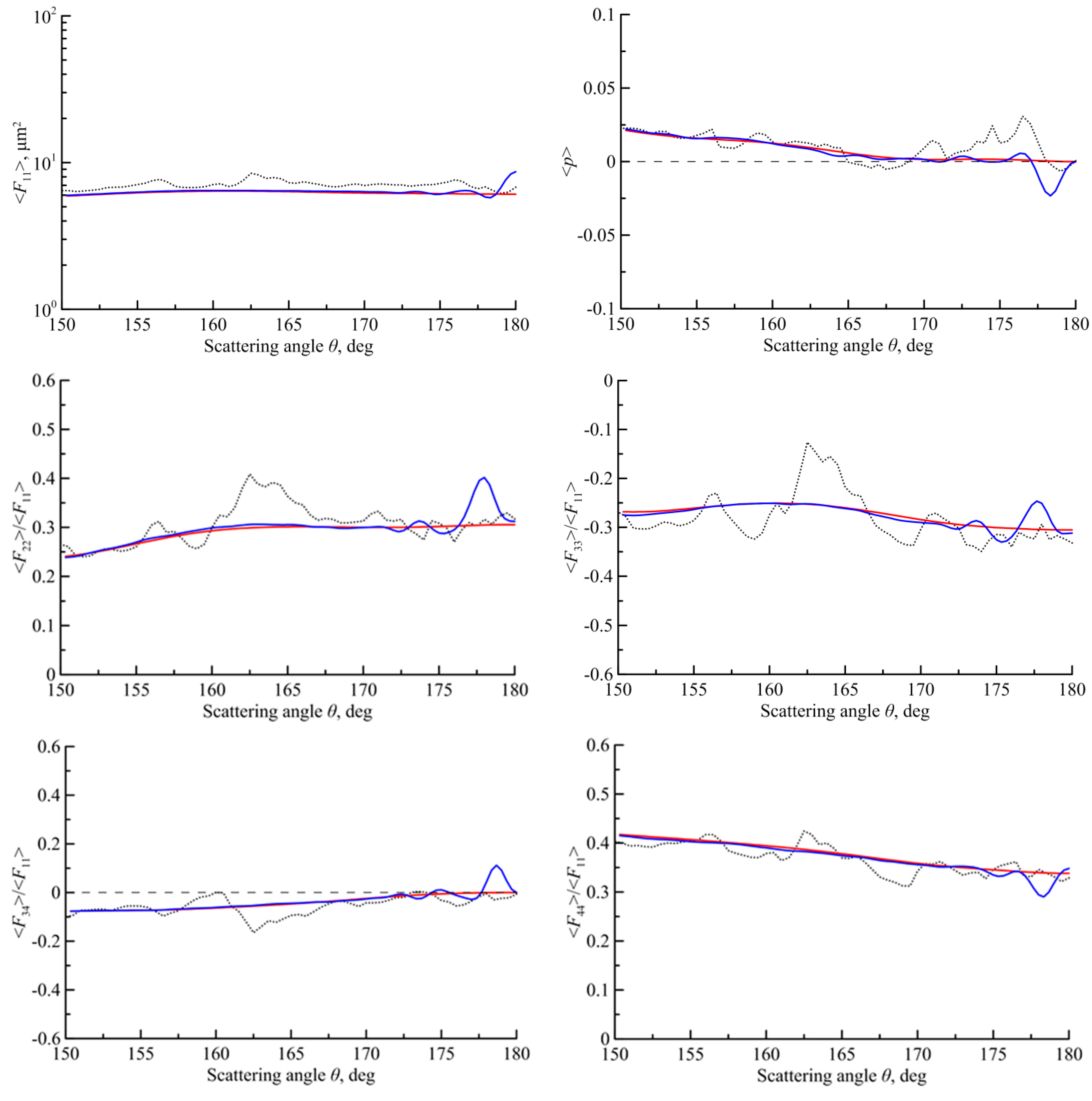

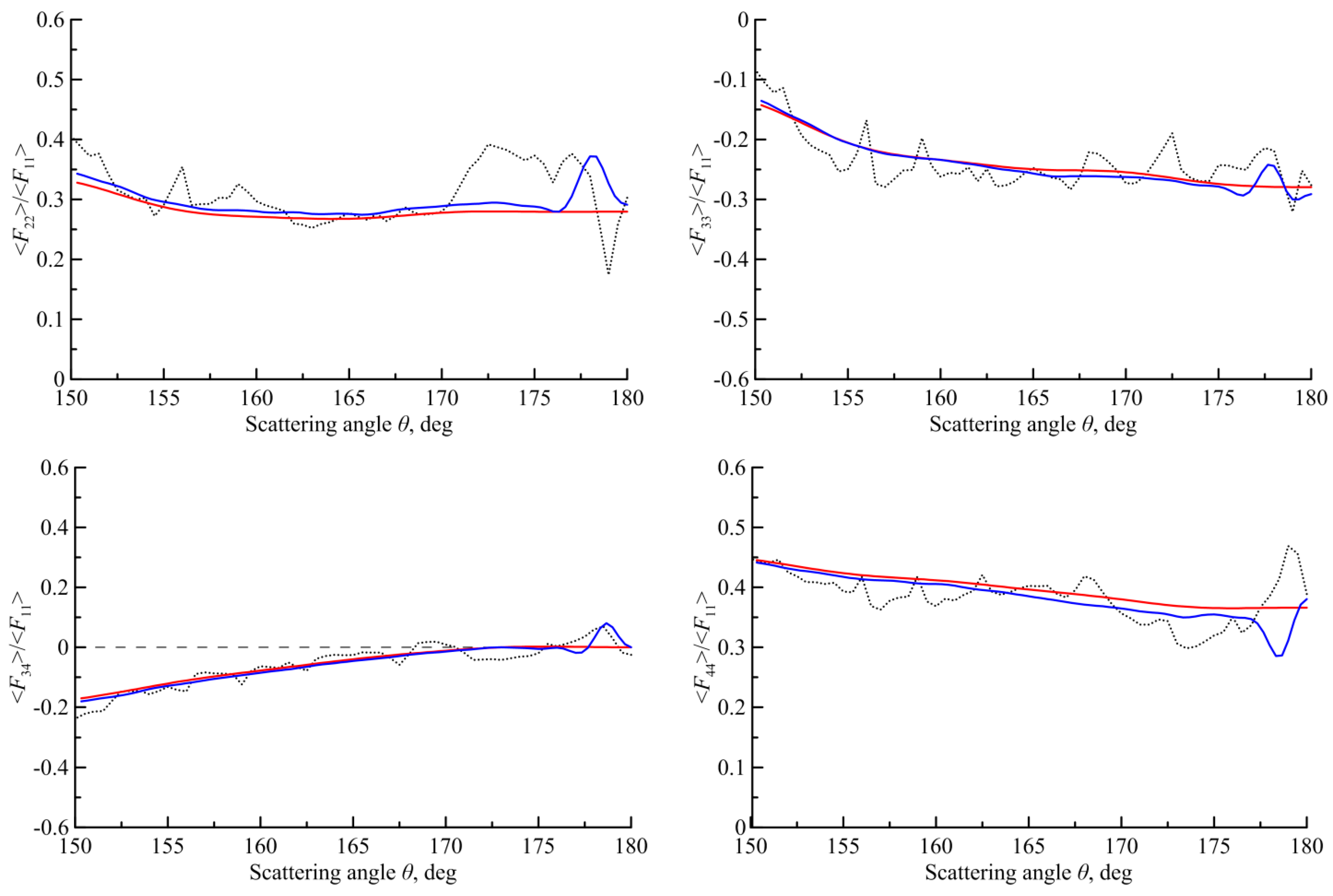
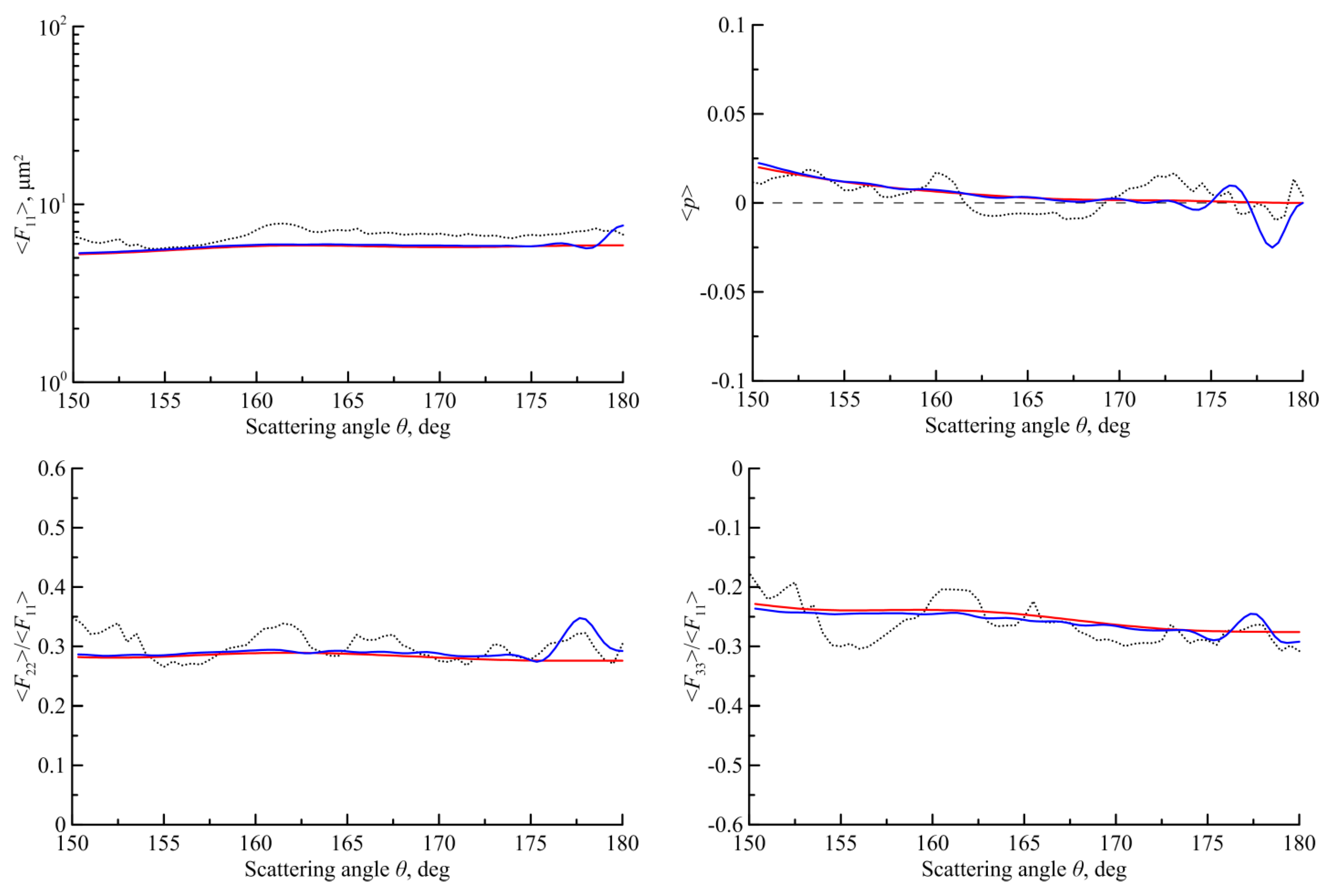


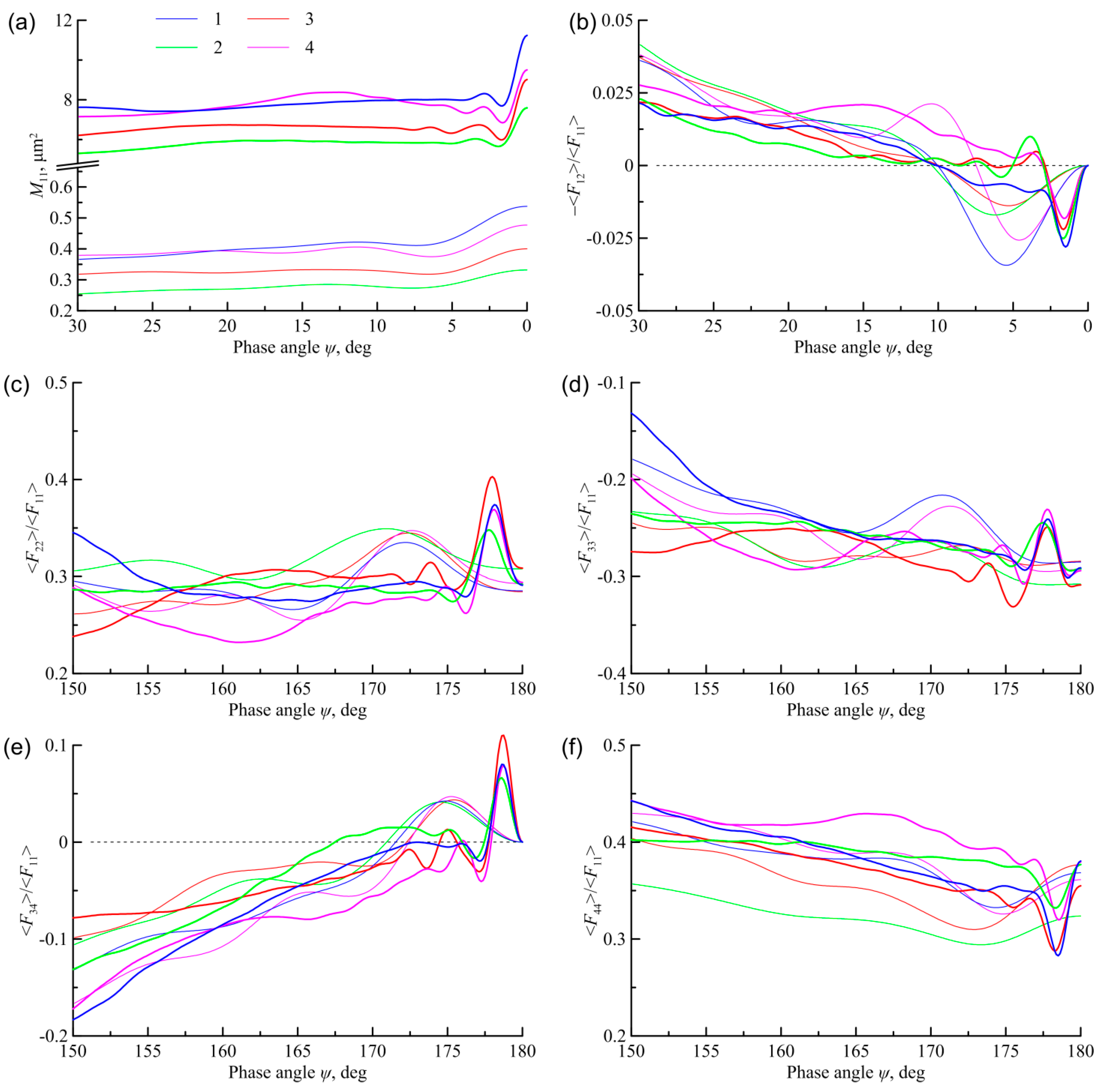
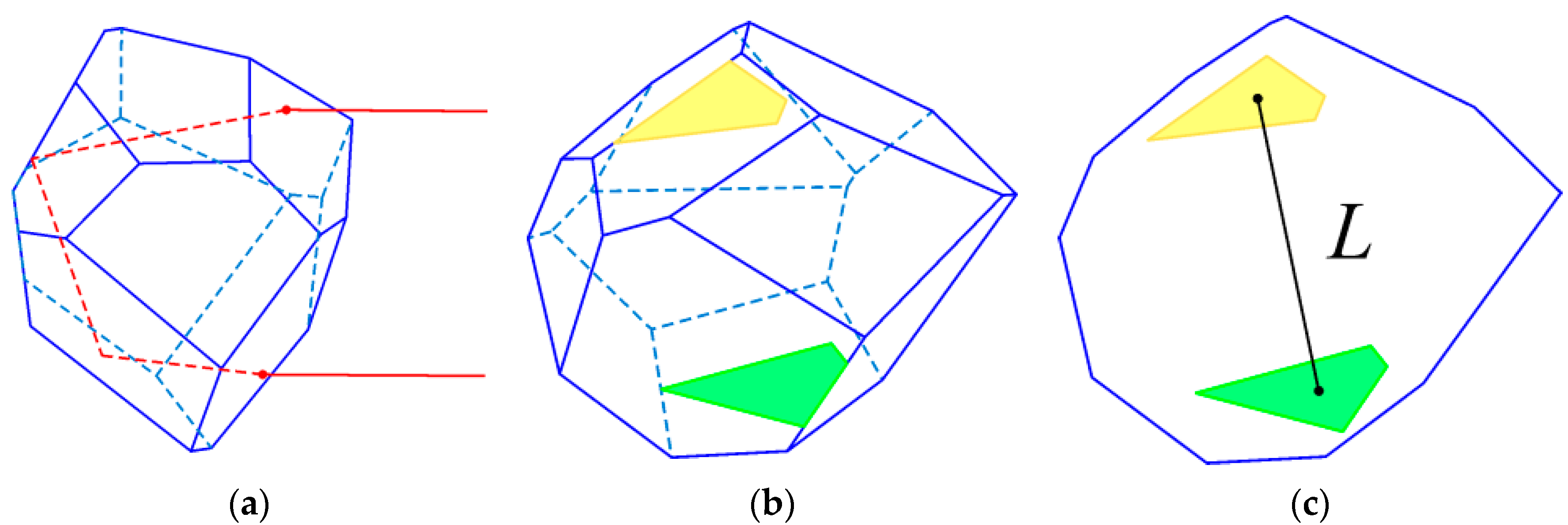
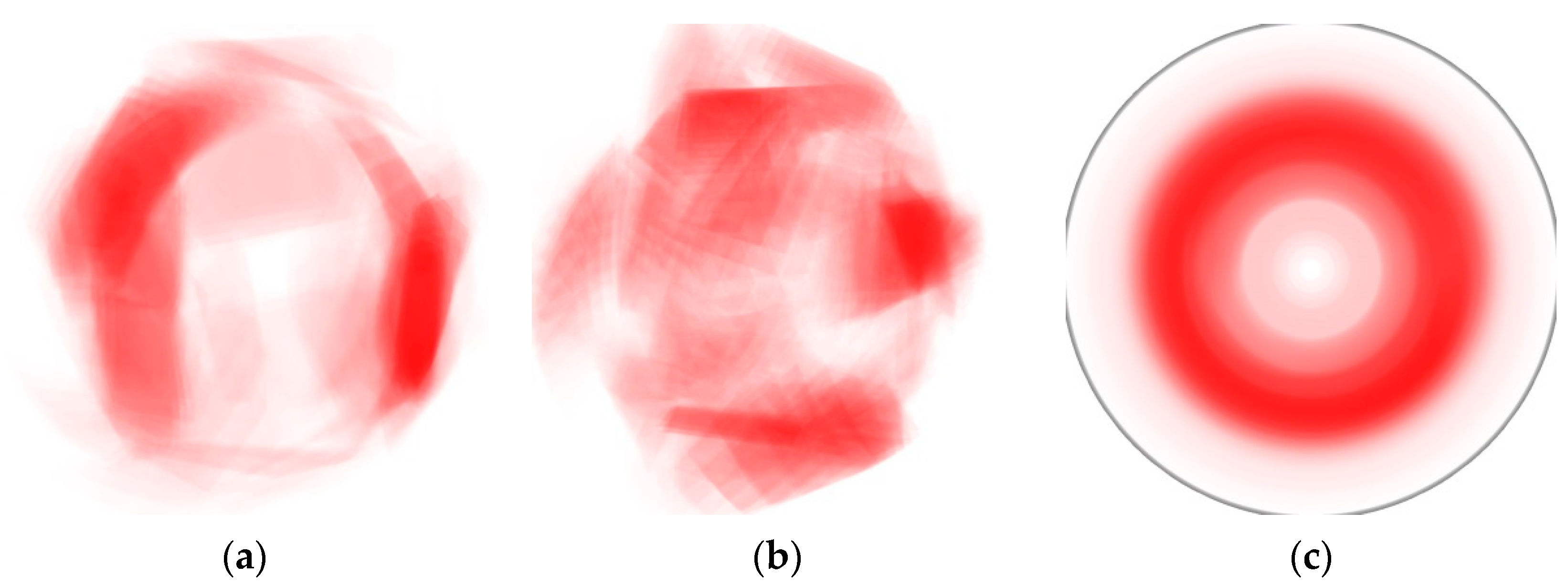
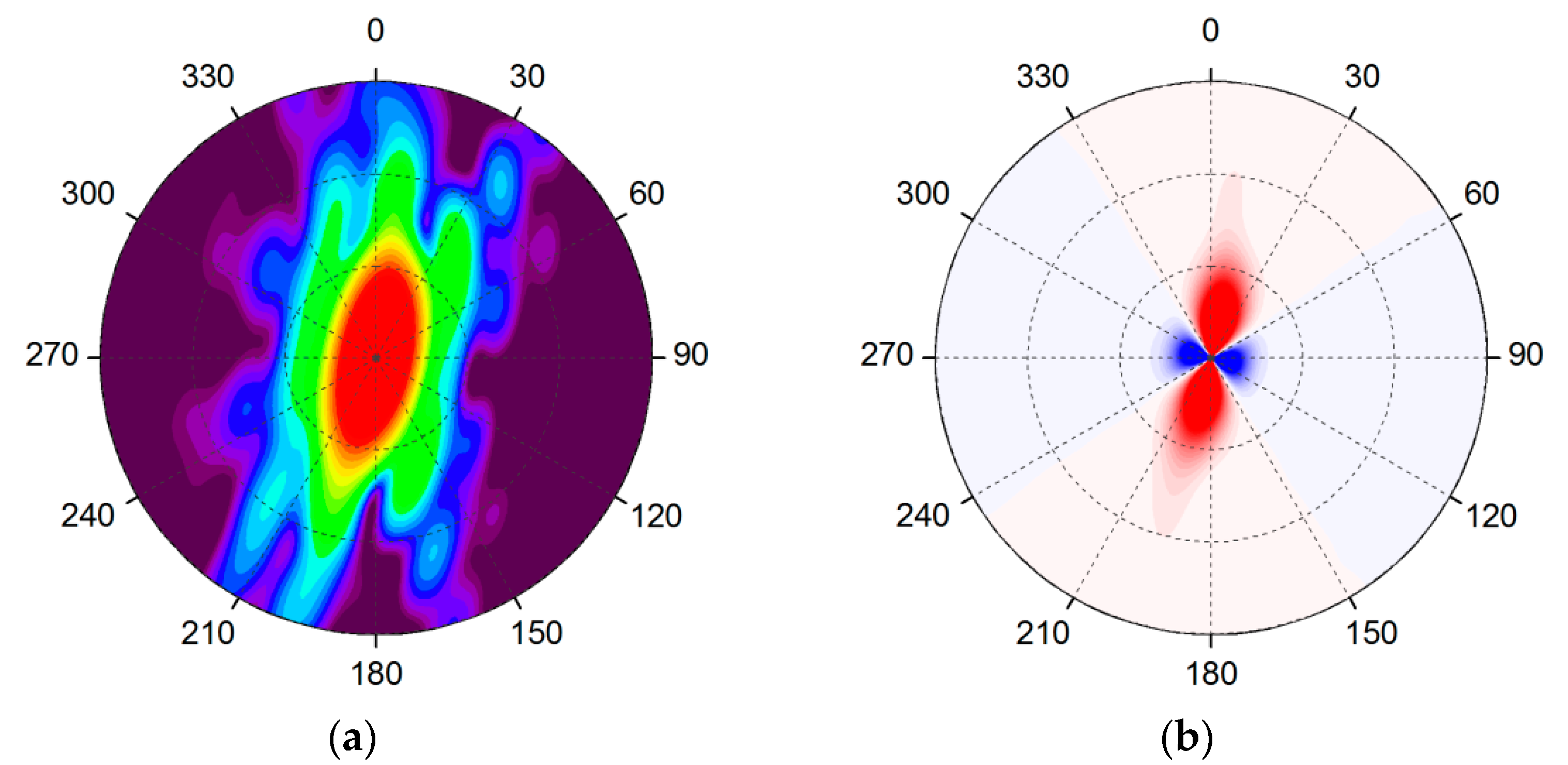
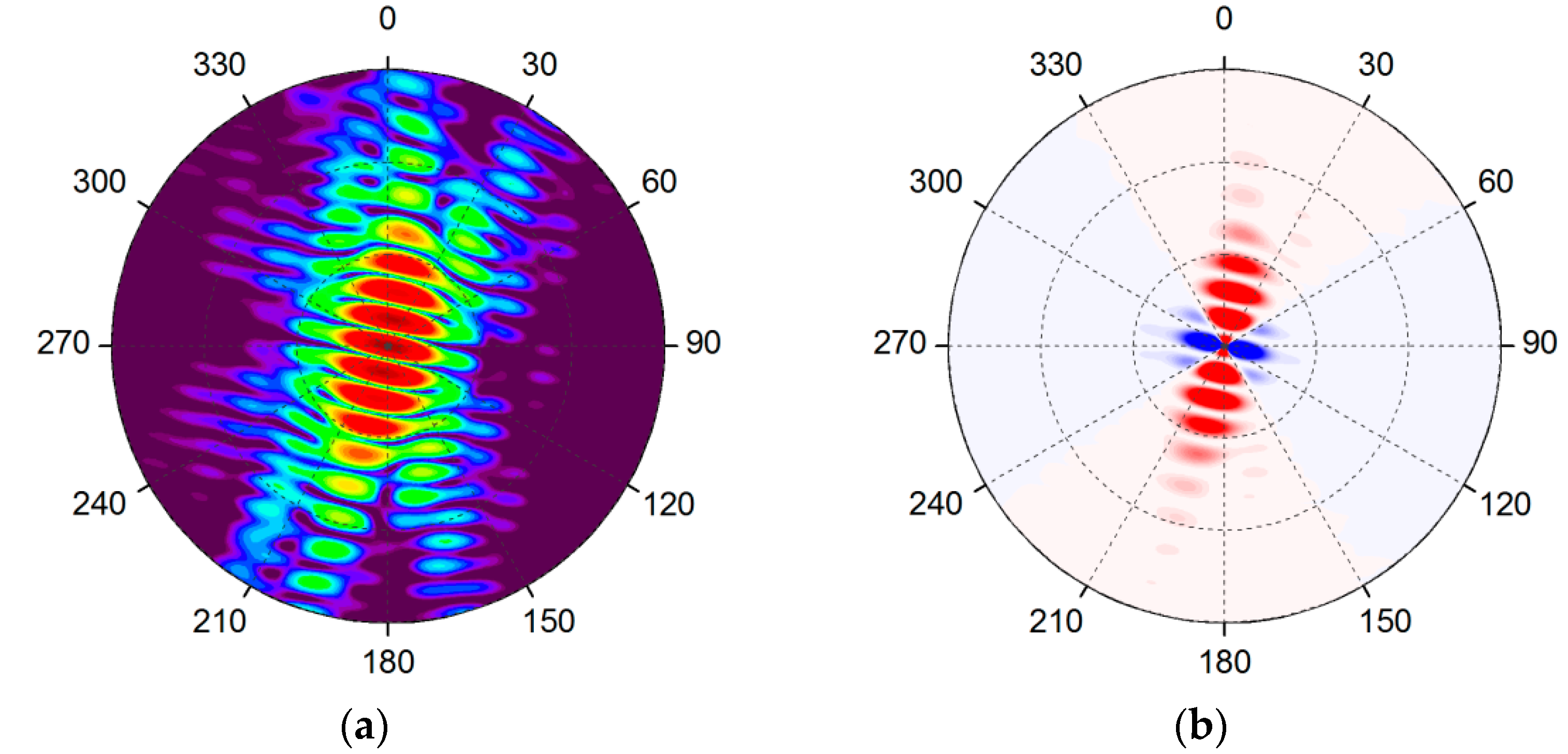

Publisher’s Note: MDPI stays neutral with regard to jurisdictional claims in published maps and institutional affiliations. |
© 2022 by the authors. Licensee MDPI, Basel, Switzerland. This article is an open access article distributed under the terms and conditions of the Creative Commons Attribution (CC BY) license (https://creativecommons.org/licenses/by/4.0/).
Share and Cite
Kustova, N.; Konoshonkin, A.; Shishko, V.; Timofeev, D.; Borovoi, A.; Wang, Z. Coherent Backscattering by Large Ice Crystals of Irregular Shapes in Cirrus Clouds. Atmosphere 2022, 13, 1279. https://doi.org/10.3390/atmos13081279
Kustova N, Konoshonkin A, Shishko V, Timofeev D, Borovoi A, Wang Z. Coherent Backscattering by Large Ice Crystals of Irregular Shapes in Cirrus Clouds. Atmosphere. 2022; 13(8):1279. https://doi.org/10.3390/atmos13081279
Chicago/Turabian StyleKustova, Natalia, Alexander Konoshonkin, Victor Shishko, Dmitry Timofeev, Anatoli Borovoi, and Zhenzhu Wang. 2022. "Coherent Backscattering by Large Ice Crystals of Irregular Shapes in Cirrus Clouds" Atmosphere 13, no. 8: 1279. https://doi.org/10.3390/atmos13081279
APA StyleKustova, N., Konoshonkin, A., Shishko, V., Timofeev, D., Borovoi, A., & Wang, Z. (2022). Coherent Backscattering by Large Ice Crystals of Irregular Shapes in Cirrus Clouds. Atmosphere, 13(8), 1279. https://doi.org/10.3390/atmos13081279





